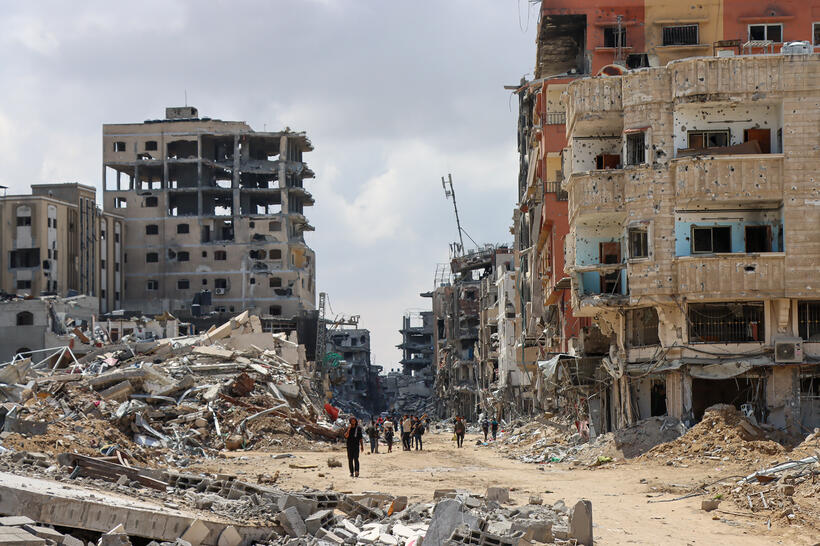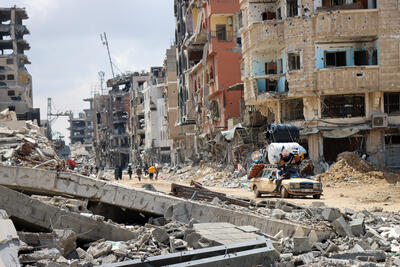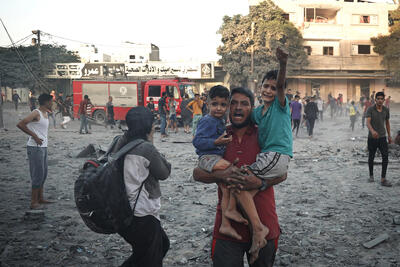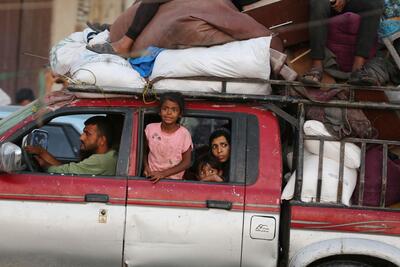Protection of Civilians Week 2024

- Start date:
- End date:
The Protection of Civilians (PoC) week, in its seventh edition, offered a space for Member States, UN entities, humanitarian organizations and affected people to share perspectives on enhancing the protection of civilians in armed conflict. PoC Week was coordinated by Switzerland, the Center for Civilians in Conflict, the International Rescue Committee and OCHA.
Throughout the week, alongside the annual Security Council Open Debate on PoC on 21 May, there were a series of engaging thematic side events on related issues. The event aimed to amplify the voices of civilians affected by armed conflict and provided a platform for field practitioners to contribute to policy discussions. Events were conducted both in person and in hybrid format.
This year held special significance as it marked the 25th anniversary of the Security Council’s consideration of the protection of civilians as an item on its agenda and the 75th anniversary of the Geneva Conventions.
Protection of civilians in armed conflict - Report of the Secretary-General (S/2024/385)
2024 Statement by members of the NGO Working Group on the Protection of Civilians
See the calendar of events
Side event details
Monday, May 20, 2024
The future of PoC in UN Peacekeeping
Reflecting on 25 years since the Security Council explicitly mandated a UN peacekeeping mission to protect civilians from threats of physical violence, 35 Member States and entities co-hosted a PoC week high-level event on the “Future of protection of civilians in UN peacekeeping”. The Under-Secretary-General for Peace Operations, Jean-Pierre Lacroix, reaffirmed that UN peacekeeping remains an indispensable and effective tool to protect civilians from threats of physical violence and that peacekeeping missions must continue to be afforded the necessary capabilities and resources to fulfill this mandate. Acknowledging the need to adjust existing tools and practices to ensure that peacekeeping remains fit for purpose amidst changing conflict and challenging geopolitical dynamics, speakers and attendees emphasized the importance of investing in early warning systems, strategic communication and the long-term capacity building of host states. Further, Member States called for a greater focus on community engagement and enhanced partnerships with regional actors.
Concept note.
25 Years of PoC and the UN Security Council: Challenges and opportunities
The purpose of this event was to take stock of the council’s engagement with PoC over the past 25 years and assess opportunities for it to further strengthen PoC norms amid contemporary political and security challenges. This conversation also took place as the international community prepared to mark the 75th anniversary of the 1949 Geneva Conventions, presenting an opportune moment for wider reflection on the fundamental principles of international humanitarian and human rights laws that underpin the PoC agenda.
Concept note 2.
Advancing the protection of aid workers
Amidst the backdrop of widespread conflicts and escalating humanitarian crises worldwide, protecting humanitarian workers is essential for delivering aid to those most in need. New and improved approaches are required, in particular with regards to national staff members. This event brought together key UN, NGO and Member States’ representatives to discuss solutions to enhance the protection of humanitarian workers in armed conflict, through addressing the gaps and challenges faced by humanitarian workers to access justice when they are the victim of attacks and improving security risk management strategies.
Summary of event
Concept note 3.
Protection through peacekeeping: Lessons from troop- and police-contributing countries
Over the last 25 years, peacekeeping personnel have drawn on policy and guidance, as well as operational lessons and experience, to protect civilians in the context of UN peacekeeping operations. Troop- and police-contributing countries have been instrumental to these efforts. Reflecting on their experiences, participants emphasized the importance of integrated activities across mission components (civilian, military, and police) to effectively carry out protection mandates. They highlighted the need for continuous reflection and imparting lessons learned to strengthen sustainable training and capacity-building, shape robust mindsets, and address gaps in strategic and operational approaches to protection. Considering the evolving nature of threats to civilians and to peacekeepers, participants stressed the ongoing need to work collectively, with the political support of member states including troop- and police-contributing countries, to strengthen efforts to protect civilians as a core component of UN peacekeeping.
Concept note 4.
Protection of civilians by African Union Peace Support Operations
Wednesday, May 22, 2024
Addressing conflict–induced hunger: Implementing resolution 2417 at national, regional and global levels
The event dealt with advancing the implementation of UN Security Council Resolution 2417 nationally, regionally and globally as a means of addressing the rising scourge of conflict-induced food insecurity and famine risk. Over the past year, UN and NGO partners organized regional multi-stakeholder roundtable discussions on the implementation of the Resolution and the role that stakeholders at regional, national, and local levels could play. This event unpacked key findings from the regional roundtables, supported improved information sharing and an increased role for civil society and affected communities, proposed solutions for conflict-induced food insecurity, and renewed high-level political commitment to improve the implementation of Resolution 2417.
Concept note 6.
Healthcare under attack: The imperative of ending the violence
The event served as a platform to raise global awareness about the continued rise in attacks on healthcare. It provided an opportunity to discuss the challenges with ensuring proper implementation and practical application with international humanitarian law in relation to protection of the wounded, sick, and medical care. It also allowed a look at best practices in supporting and strengthening healthcare systems after attacks to issue concrete recommendations to Member States and other stakeholders on steps to strengthen legal and practical protections for healthcare in conflict.
Concept note 7
Advancing gender-transformative and gender-responsive approaches in protection interventions: Trafficking, conflict-related sexual violence and financial exclusion
The overall objective of the event was to raise awareness and action on the need for gender-responsive and transformative approaches in protection interventions for people vulnerable to modern slavery and human trafficking. The vulnerable included those excluded from the formal financial system and also those who had experienced conflict-related sexual violence. The event had a specific focus on diverse and intersectional experiences, including the experiences of men and boys in conflict and crisis.
Concept note 8.
Protecting civilians from harm: Strengthening accountability for private military and security companies
The event looked at protection risks to civilians resulting from the behavior of private military and security companies and mercenaries. It explored accountability gaps for civilian harm caused by these actors and examined possible pathways toward improved accountability, offering both lessons and examples informed by first-hand experience and research.
Concept note 9.
Thursday, May 23, 2024
Protecting civilians from explosive weapons in populated areas
The use of explosive weapons in populated areas is a leading cause of harm to civilians in armed conflict, with both immediate and long-term effects. 2023 saw unprecedented levels of harm from explosive weapons, resulting in high levels of civilian deaths and injuries, and hampering access to aid, education, healthcare, and essential services. During PoC Week, a focused discussion addressed humanitarian consequences of explosive weapons in populated areas, and how the Political Declaration on Strengthening the Protection of Civilians from the Humanitarian Consequences Arising from the Use of Explosive Weapons in Populated Areas could help to prevent and address these.
Concept Note 10.
Sparing water from armed conflicts for enhanced protection of civilians – A launch of the Global Alliance
This was the first event in the framework of the PoC Week focusing exclusively on the critical issues surrounding the impact of armed conflict on freshwater and water-related infrastructure. It shed a light on the consequences of destruction, damage and disruption of water services on civilians, especially children, women, and older persons. The discussion cautioned the audience about direct and indirect impacts, as well as about the long-term reverberating effects that include contamination, spread of deadly infectious diseases, malnutrition, and other environmental hazards.
Speakers condemned deliberate attacks on objects indispensable to the survival of the civilian population, including freshwater and water-related infrastructure, and recalled the prohibition of such attacks as a method of warfare in conflict situations, demanding closer attention in intergovernmental fora, including the UN Security Council. Good practices and possible ways forward were also presented. The discussion displayed the need for a platform to galvanize efforts to protect water from the consequences of armed conflicts at all levels and inspired the launch of the Global Alliance to Spare Water from Armed Conflicts.
Revisit the discussion or learn more about the Global Alliance.
Concept note 11.
Civilian-centered approaches to PoC: What works, why and advancing acceptance within the international system
Community-led protection, a civilian-centered approach to PoC based on principles of unarmed action, non-violence, and the primacy of local actors, have been successfully employed to protect civilians in numerous conflict-affected regions. The session examined what had worked and why, what lessons had been learned, and what was needed at both field and policy levels to more fully raise awareness and integrate, coordinate, and internalize unarmed, civilian-led approaches into institutional protection efforts.
Concept note 12.
Addressing the impact of mis-/disinformation and hate speech on civilians: Evolving policies and practices from peacekeeping and humanitarian actors
Misinformation, disinformation, and hate speech continue to threaten the safety and security of civilians in armed conflicts and humanitarian crises. With mis-/disinformation and hate speech perpetuated both offline and online in such contexts, those with existing vulnerabilities, such as displaced and stateless persons, journalists, human rights defenders, and youth, tend to be among those most acutely affected. In responding to harmful information, participants highlighted the need to adopt a protection lens in peacekeeping and humanitarian settings and to center related initiatives around strengthening the skillset and resilience of local communities. Furthermore, speakers emphasized the necessity of building inclusive organizational policies, developing multi-stakeholder partnerships, and engaging the tech sector in prevention and response efforts to enhance the protection of civilians in different humanitarian and conflict-affected settings. Member states also welcomed the discussion of examples of legislation, strategies, and pilot programs that could assist in addressing the root causes of these phenomena.
Concept note 13
Recording
Friday, May 24, 2024
Protection needs of young peacebuilders at the field level: Global policy considerations
The side event gathered Member States, UN high-level officials, civil society, and young people. Discussions highlighted the need for comprehensive protection mechanisms for young peacebuilders, crucial for sustainable peace. Recommendations focused on better including young people and young peacebuilders in policy development and decision-making processes, strengthening policy language on Youth, Peace, and Security, improving data collection for evidence-informed policy and funding, increasing dedicated funding for young people’s protection, building a holistic approach to protection, adapting global policies to national contexts, enhancing the capacity of young people and institutions, and improving monitoring and accountability of commitments.
Concept note 14
Video recording
Taking stock of 25 Years of PoC in peacekeeping: Lessons learned and opportunities for future research and practice
As the international community marks the 25th anniversary of the first POC mandate in a UN mission, the purpose of this event was to: (1) Take stock of the academic and policy research on POC over the last two and a half decades, with a specific focus on the efficacy of POC mandates within peacekeeping operations; (2) Articulate clear operational recommendations emerging from academic and policy research on the implementation of POC mandates; and (3) Begin to develop questions that can underpin the next phase of POC research.
Concept note 15.
Strengthening the continuity of protection during and after UN mission transitions and withdrawals
This side event aimed at advancing engagement on the protection implications stemming from recent UN mission transitions and withdrawals. Through a panel discussion featuring key protection actors, it enhanced awareness and action in supporting the continuity of PoC during and after these withdrawals. Speakers with first-hand experience in contexts like Democratic Republic of the Congo, Sudan, and Mali offered insights and lessons learned, addressing changing protection capacities and mechanisms. The session considered implications for policymakers and practitioners in various contexts and explored needed support to ensure the safety and protection of those affected by crisis.
Concept note 16.
Engaging weapon bearers for the protection of civilians
The event highlighted essential strategies to ensure the continuity of protection during and after UN transitions and mission withdrawals. Speakers examined the impact of these transitions on civilian protection, the interventions by protection actors, and the lessons learned. Emphasizing community-based and civilian-led approaches, the discussion underscored the importance of planning for mission withdrawal from the start, focusing on capacity building with national actors, civil society, and communities. Comprehensive PoC plans and localized support were identified as best practices. The speakers stressed that mission transitions often occur amid escalating conflict, highlighting the need for clear risk mitigation and the shared responsibility of protecting civilians. The event brought together diverse perspectives to explore how to mitigate protection risks and enhance protection outcomes for affected populations.
Concept note 17.



